
Insects in the family Tettigoniidae are commonly called katydids, or bush crickets. They have previously been known as "long-horned grasshoppers". More than 8,000 species are known. Part of the suborder Ensifera, the Tettigoniidae are the only extant (living) family in the superfamily Tettigonioidea.

The family Gryllidae contains the subfamilies and genera which entomologists now term true crickets. Having long, whip-like antennae, they belong to the Orthopteran suborder Ensifera, which has been greatly reduced in the last 100 years : taxa such as the spider-crickets and allies, sword-tail crickets, wood or ground crickets and scaly crickets have been elevated to family level. The type genus is Gryllus and the first use of the family name "Gryllidae" was by Francis Walker.
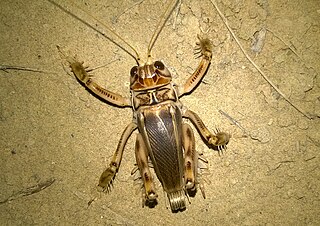
Schizodactylidae is a family of orthopteran insects found in Asia and southern Africa, known as dune crickets or splay-footed crickets. They are usually found in desert and sandy areas. Species are predatory, including Schizodactylus inexspectatus. T. B. Fletcher notes that one captive individual did not feed on any vegetable matter. Fossils are known since the Early Cretaceous.
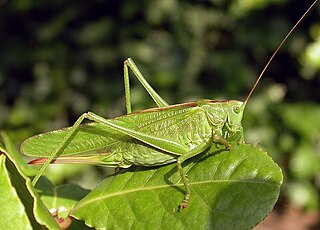
The Tettigoniinae are a subfamily of bush crickets or katydids, which contains hundreds of species in about twelve tribes.

Metrioptera is a genus of insects in the tribe Platycleidini and subfamily Tettigoniinae, include the bog and meadow bush crickets. They are found in Eurasia.

The Phaneropterinae, the sickle-bearing bush crickets or leaf katydids, are a subfamily of insects within the family Tettigoniidae. Nearly 2,060 species in 85 genera throughout the world are known. They are also known as false katydids or round-headed katydids.
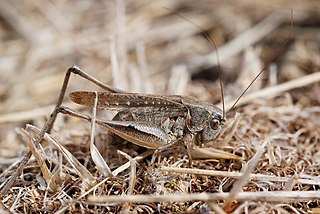
Platycleis is a genus of bush crickets described by Fieber in 1853, belonging to the subfamily Tettigoniinae. The species of this genus are present in Europe, North Africa and temperate Asia.
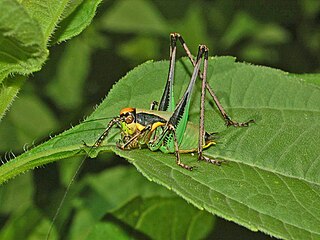
Eupholidoptera is a genus of bush crickets belonging to the subfamily Tettigoniinae.

Mecopodinae are a subfamily of bush crickets found in western South America, sub-Saharan Africa, and Asia. In Asia, the distribution includes India, Indochina, Japan, the Philippines, and Malesia to Papua New Guinea and Australasia, including many Pacific islands.

Atlanticus is a genus of "eastern shieldback" bush crickets or katydids in the tribe Drymadusini. It has a discontinuous recorded distribution in North America and temperate eastern Asia.
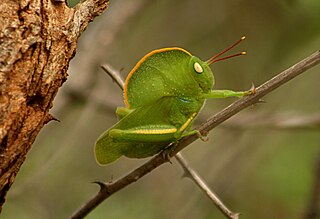
Teratodinae is a subfamily of grasshoppers in the family Acrididae. There are about 8 genera and more than 20 described species, found in East Africa and South-West Asia.

Roeseliana is a genus of bush cricket or katydid in the subfamily Tettigoniinae. Species in this genus were placed at various times in the genera Metrioptera and Bicolorana, until Roeseliana was restored in 2011, with these and other similar genera placed in genus group Metrioptera.
Pterophyllini is a tribe of true katydids in the family Tettigoniidae. There are about 16 genera and more than 40 described species in Pterophyllini.

Gampsocleis is a genus of bush crickets in the subfamily Tettigoniinae and tribe Gampsocleidini.
Nocaracris is a genus of European and western Asian grasshoppers in the family Pamphagidae, erected by Boris Uvarov in 1928. It is the type genus of the tribe Nocarodeini and has a recorded distribution of Greece through to Afghanistan, but this may be incomplete.
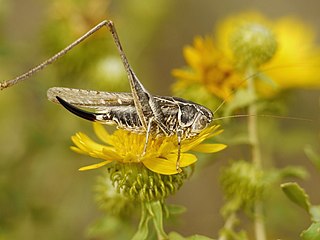
Montana is a genus of bush crickets in the tribe Platycleidini, erected by F.E. Zeuner in 1941. The type species, M. montana has been called the "Steppe Bush-Cricket". Some authorities previously placed this as a subgenus of Platycleis, but it is now considered a separate genus, as part of the genus group Platycleis. Species can be found in the northern Palaearctic realm from mainland western Europe through to Siberia.

Anadrymadusa is a genus of bush crickets in the tribe Drymadusini, erected by Tevfik Karabağ in 1961. Species have been recorded from Greece and Turkey through to Afghanistan.

Anterastes is a genus of Palaearctic bush crickets in the tribe Platycleidini, erected by Carl Brunner von Wattenwyl in 1882. Species can be found in South-eastern Europe, with most records from the Balkans, Greece and Turkey.
Xerohippus is a genus of Palaearctic grasshoppers in the tribe Dociostaurini erected by Boris Uvarov in 1942. Species are recorded from North Africa, the Iberian peninsula and the Middle East up to the Black Sea.















